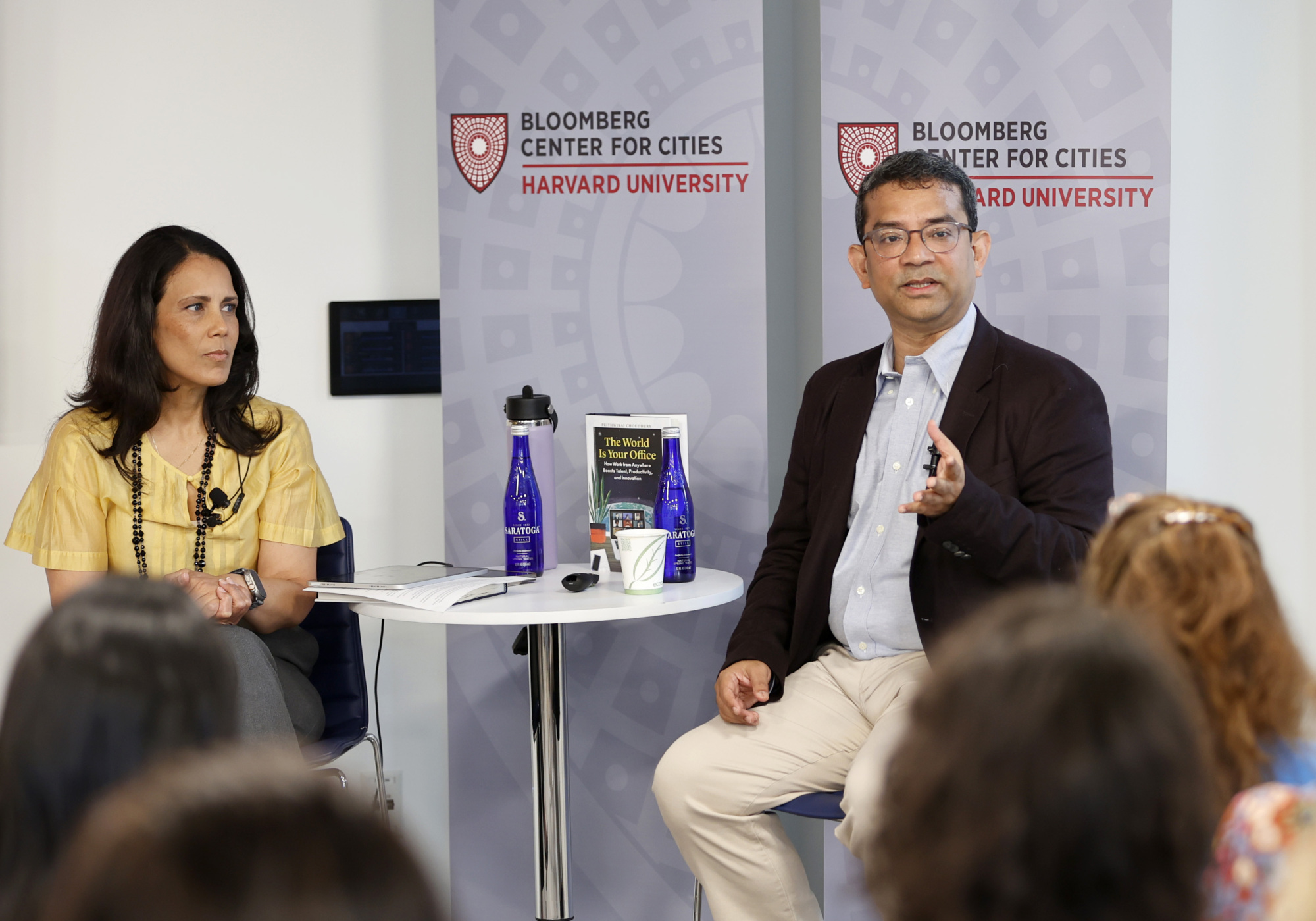Cambridge, Massachusetts (June 18, 2025)—Even as debates continue about remote work and return-to-office policies, the geography of work is shifting, creating new opportunities for cities.
That was the recurring message of a hybrid conversation at the Bloomberg Center for Cities featuring Harvard Business School professor Prithwiraj (Raj) Choudhury, author of The World Is Your Office: How Work from Anywhere Boosts Talent, Productivity, and Innovation. He joined Michelle De La Isla, CEO of Hack.Diversity and former mayor of Topeka, Kansas, to explore how geographic flexibility is transforming talent distribution and reshaping civic life.
Flexibility, Talent, and the Future of Cities
In The World Is Your Office, Choudhury documents how work-from-anywhere models are providing new options for employers seeking talent, employees deciding where to live and work, and cities seeking to plan and build for the future. Drawing on more than a decade of research, he reveals how actual worker behavior is evolving, delivering insights for leaders grappling with the challenges of economic development, downtown revitalization, and community building.
“Work from anywhere is not the same as work from home,” Choudhury emphasized at the event. “It’s about giving people the freedom to choose where to live—which city, which town, which country.” That freedom, he said, has profound implications—for individuals seeking affordability or to be closer to family; for couples, including military families, where one partner’s opportunity once meant the other’s career was sidelined; and for cities competing to attract residents and build economic vitality. “Leaders have to recognize that in this labor market you cannot ignore flexible work practices,” he said.
New Opportunities for Cities
Choudhury’s research shows that geographic flexibility reduces attrition and expands access to skilled workers, while also benefiting communities where those workers choose to live. For cities, it’s a chance to attract new residents who bring jobs with them.
In fact, at least 50 heartland cities now offer incentives to remote workers, aiming to reverse population decline and stimulate local economies. Places like Tulsa, Oklahoma are showing how a thoughtful work-from-anywhere strategy can generate long-term gains. Choudhury pointed out that city governments often struggle to attract companies to town when there aren’t enough workers. And people are reluctant to move to places with scant work opportunities. “It’s a chicken and egg situation,” he said. “But remote work breaks that cycle because the remote workers are coming with their jobs. They don’t need a local job.”
Reimagining Work Culture—and Downtowns
The shift isn’t about abandoning offices—it’s about reimagining them. In-person time, Choudhury noted, remains important, but it must be intentional. His research supports a hybrid model where teams gather roughly 25% of the time—on a weekly, monthly, or even quarterly basis—to brainstorm, mentor, and build culture. “Off-sites are becoming the new office,” he said.
These changes ripple beyond organizations. They influence how cities approach infrastructure, zoning, and downtown redevelopment. In some metros, commercial districts are being adapted for housing and mixed use. Meanwhile, mid-sized and rural cities can now compete for talent in ways that were once out of reach.
To support these shifts, cities and employers alike must invest in systems and spaces that support flexible work—from public infrastructure and community-building initiatives to inclusive broadband access and new models of coworking. And leaders must adapt and strengthen their strategic approaches to make the most of the opportunities ahead.
Tackling New Questions
The event sparked wide-ranging questions from an engaged audience—both in person and online—on topics including the future of commercial real estate and city planning; the inequities faced by public sector employees in roles like public safety and education where remote work isn’t possible; the challenges of adaptive leadership in a shifting environment; and strategies for sustaining culture and collaboration across hybrid teams and in communities.
While many important questions remain to be resolved, Choudhury offered research-backed optimism about an emerging landscape where workers thrive with new choices and cities and employers benefit from well-designed flexibility. For civic leaders, the question isn’t which “side” to choose, but how to innovate for the labor market’s realities—intentionally, inclusively, and with an eye to the future.
Related Resources
Are Your City’s Policies as Dynamic as Your Residents’ Preferences?
Are Your City’s Policies as Dynamic as Your Residents’ Preferences?
When it comes to understanding your city’s dynamic environment and the changing preferences of residents, this research suggests that big data can not only help city officials learn about their communities in real time but also with discovering where to exercise control, when to change tactics, and what the future may hold.
When Innovation Causes Conflict: Ostrich, Chameleon, and Dolphin Strategies in the Public Sector
When Innovation Causes Conflict: Ostrich, Chameleon, and Dolphin Strategies in the Public Sector
Public sector innovation often involves disputes over what is most important. All too frequently, these “value conflicts” can undermine or even derail the new policy, tool, program, or process you are seeking to implement. This research argues that innovators can overcome such obstacles by paying at least as much attention to the design and management of the process of innovating as to the innovation itself.



